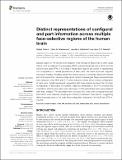Distinct representations of configural and part information across multiple face-selective regions of the human brain
Author(s)
Golarai, Golijeh; Ghahremani, Dara G.; Eberhardt, Jennifer L.; Gabrieli, John D. E.
DownloadGolarai-2015-Distinct representat.pdf (1.830Mb)
OPEN_ACCESS_POLICY
Open Access Policy
Creative Commons Attribution-Noncommercial-Share Alike
Terms of use
Metadata
Show full item recordAbstract
Several regions of the human brain respond more strongly to faces than to other visual stimuli, such as regions in the amygdala (AMG), superior temporal sulcus (STS), and the fusiform face area (FFA). It is unclear if these brain regions are similar in representing the configuration or natural appearance of face parts. We used functional magnetic resonance imaging of healthy adults who viewed natural or schematic faces with internal parts that were either normally configured or randomly rearranged. Response amplitudes were reduced in the AMG and STS when subjects viewed stimuli whose configuration of parts were digitally rearranged, suggesting that these regions represent the 1st order configuration of face parts. In contrast, response amplitudes in the FFA showed little modulation whether face parts were rearranged or if the natural face parts were replaced with lines. Instead, FFA responses were reduced only when both configural and part information were reduced, revealing an interaction between these factors, suggesting distinct representation of 1st order face configuration and parts in the AMG and STS vs. the FFA.
Date issued
2015-11Department
Harvard University--MIT Division of Health Sciences and Technology; Massachusetts Institute of Technology. Department of Brain and Cognitive SciencesJournal
Frontiers in Psychology
Publisher
Frontiers Research Foundation
Citation
Golarai, Golijeh, Dara G. Ghahremani, Jennifer L. Eberhardt, and John D. E. Gabrieli. “Distinct Representations of Configural and Part Information Across Multiple Face-Selective Regions of the Human Brain.” Front. Psychol. 6 (November 6, 2015).
Version: Final published version
ISSN
1664-1078